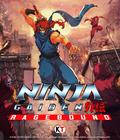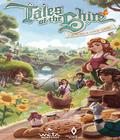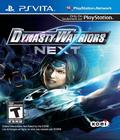The Dynasty Warriors franchise is polarizing for most gamers. Some enjoy the mindless action of single-handedly taking down entire armies in ancient China while others argue that there's no depth or evolution in the series since the PS2 debut of Dynasty Warriors 2. While it's become a niche series in North America, it's still doing well in Japan, spawning several sequels, spin-offs, and creating plenty of imitators. The presence of a new portable console has returned the series to the portable space with Dynasty Warriors Next, a game that pleases fans and may bring some newcomers and naysayers back into the fold.
The story remains the same and is loosely based on stories from the Romance of the Three Kingdoms. You take on the roles of several prominent figures of ancient Chinese history. Like earlier games in the series, you'll go through famous periods of the country's history, including the Yellow Turban rebellion, the battles of Chibi and Jiangdong, and the formation of the three kingdoms.
The core gameplay also remains the same. You select a land to invade, equip your officer, and then head out into battle. Your officer is powerful enough to take down hundreds of soldiers and hit tens of enemies at a time. Along the way, you'll capture bases to gain reinforcements, power up your weapons, weaken the enemy, or capture the main base to end the battle. While the game is purely action, some stages let you assign officers to attack or defend certain bases in real time.
For the first time in a while, some changes have been made to the gameplay. Strategems can be implemented where you spend gold to get bonuses for the fight, including increased base defense or increased attack power. At certain times in the battle, you'll be ambushed and sent into different scenarios where you deflect enemy attacks or knock enemies out of the air with screen taps and slashes. Succeeding gets you an attack bonus or new equipment while failing means you lose energy. That isn't permanent thing, though, as the game has no on-screen energy meter, opting instead for a regenerative health system that's popular in modern shooters.
Dynasty Warriors Next employs different special attacks that are more interactive than powering up and slashing away until the power subsides. Depending on your character, you can shake the system to deliver bigger blasts, slash at the screen to inflict wider blows, or tap the rear touch pad to hit multiple areas at once and juggle enemies. Finally, the game transitions away from mass fighting into a more intimate duel affair when a boss or major opponent comes in contact with you. You slash at the screen to deflect and parry blows in addition to inflicting hits of your own. During a weapon lock, you hit various spots to disengage the lock and gain the upper hand before furiously slashing at the screen to finish off an enemy. Finally, the time limit for each level has been removed, so players can take as long as they need to complete a stage.
The changes add something different to the mass slaughter of dumb foot soldiers. The lack of an energy meter makes it more accessible for those who panic when they run low on health. Even though 30 minutes seems like more than enough time to finish a stage, removing the timer also removes any stress. The ambush moments relieve a player from the constant button-mashing of combat, and their appearances aren't frequent enough to be annoying. The only part that doesn't live up to the potential is the duels. Even though they're supposed to be more strategic, you end up doing the equivalent of button-mashing with the constant swipes that inflict damage on the opponent. That takes away from what could have been a great addition to the series and reduces it to being a curious addition instead.
There are four different game modes. Campaign mode is where you'll follow the Romance of the Three Kingdoms story from beginning to end. Unlike past games, the story is told in a linear fashion, so you'll almost always be forced into fighting in a particular territory with a particular officer. There are a few bouts where you can select who you'll play as and which officers will be your subordinates, but even then, you're restricted to the faction that's the current focus of the story. Going through the campaign gives you new weapons and new costume pieces, but the story is more coherent than before. CG cut scenes and narrated text help the story stay focused, and the shifts between characters try to help you keep track of the major players. Admittedly, it is difficult to keep track of over 65 different characters, but it's a commendable effort to make everything less confusing; past games didn't make any effort to do this.
Conquest mode acts as a portable version of the Empires entries, though with some interesting twists. You're given a map with a random assignment of lands and a faction choice. Your officer choices aren't restricted to faction, and you can even pick your created officer. From there, lands randomly level up, and if your plot of land has a higher ranking than a plot that is occupied by someone else, you can invade it. Then, the game plays out normally, with a successful battle granting you that land as a prize. However, fights are limited in that if someone invades your land, you can't fight to defend it. Defeating the ruler of a particular set ensures that you get all of their previously held lands as the prize, and the game ends once you've taken over all of the land. While there's some strategy to the game, there's also an equal amount of luck that determines your success. The game randomly pulls created characters into your fight, and with people investing a huge amount of time in the game, you'll see some very high-level officers go up against your fighter. While this makes things more difficult, you have the chance to defeat that officer and have him or her join your ranks for future Conquest modes. It's a real incentive to replay the mode.
Coalition mode is the multiplayer mode, but it can also be played solo if desired. You can pick your officer, whether official or user-made, and go into battle with up to three other people on four different game types. Sentinel is the game's Horde mode, where you have a set amount of time to protect your base from waves of incoming enemies. Marauder is the classic game where you have to conquer all of the bases in the map under a time limit. Blitz does the same but is focused on taking over the main enemy camp; the takeover of other bases acts as time extenders. Then there's Sudden Death, where base takeover is still the goal, but one hit kills you. The modes are fun because mindless slaughter has always been more enjoyable with others in tow. However, the multiplayer is only in ad hoc mode and not online. It's disappointing to have gameplay restricted to local multiplayer, but this raises some red flags for players. One of the main complaints from the PSP era was that some of the better multiplayer experiences were hampered by being local affairs although the system was capable of online play. Part of the blame can be placed on the PSP's 802.11b spectrum, but with a new system capable of 802.11g and n speeds on Wi-Fi, seeing a mode that would be perfect for online play remain offline makes one hope that this isn't the continuation of a bad trend.
Gala Mode is home to some minigames that vary in terms of quality. Steeplechase has you racing on horseback as you try to get to the goal as quickly as possible while knocking over enemies. Marksman has you on a crossbow in a timed challenge to see how many kills you get before time runs out or you lose energy. Bastion lets you slash as many people as you can in first-person mode before time runs out. Those modes are amusing enough because they use the system's new features in combat situations. Calligrapher is interesting; before time expires, you use the rear touch pad to uncover the symbol and paint over it again with the touch-screen. It makes for a decent distraction, but you most likely won't find yourself playing this often. Then there's Musou Snapshots, where you take pictures and then augment with clip art from the game. It'll appeal to a niche audience that loves taking sticker pictures and Dynasty Warriors or those who like to make artificially goofy pictures. Oddly enough, it only seems to function with the rear camera. It won't pick up the front camera, so those who want to take wacky pictures of themselves are out of luck here.
The controls are rather well implemented, though it can all feel odd at first. The standard controls work as well as expected, so the learning curve is minimal. Touch-screen controls are responsive enough, but the interactive map doesn't function as easily as the other combat-related touch controls. The rear touch pad is also responsive, though it can become problematic with the crossbow in Marksman mode since you'll likely touch it without knowing it and deplete your arrow cache rather rapidly. The gyroscopic movements also work nicely, but the constant shaking and moving causes you to lose focus on the screen.
The power of the Vita certainly helps the game's graphics, but they still remain flawed. Environments and major characters look sharp and as detailed as one could get on five inches of screen space. Thanks to the OLED screen, colors are vibrant with no ghosting, and the animations and particle effects come through as well as they do on the home consoles. The common foot soldiers continue to look like clones, but that tends to be forgiven when you realize that there are more soldiers populating the screen than ever before in the game's history. There are only a few times when you're moving from base to base and don't feel like you're being choked out by the mass of people. There's still pop-up in the game, and while the environments seem immune, the characters aren't. There's rarely a time when soldiers, both friendly and enemy, don't just pop up right in front of you. There are also more elegant approaches, like them coming from buildings and through gates. It is something the series has struggled with for a while, and it looks like it will continue to fight that battle in the new portable space.
Likewise, the sound isn't perfect, but fans will be pleased with the familiarity. The music is comprised of hair metal rock with an emphasis on electric guitars. The style of music has been associated with the series for so long that the orchestral music in the theme song, as good as it is, feels out of place. The effects haven't changed, but you won't hear the clanging of armor as you walk like you did before, and the voices also remain the same. There's no option to change it to Japanese, and the dialogue remains limited in the battlefield, though the delivery is good in the cut scenes. You won't miss much if you play the game silently, but you won't regret listening to it, either.
Dynasty Warriors Next is a sign that, slowly but surely, Tecmo Koei and Omega Force are willing to add some innovation to their long-running series. The inclusion of minigames in battle is a nice touch, and the stronger narrative focus in Campaign mode goes a long way in helping non-fans get interested in the lore. The multiplayer is fine, and while the lack of online play is disappointing, the asynchronous mode is enjoyable enough. The core of the game is exactly the same as before, despite the inclusion of touch- and gyroscope-based elements, and your enjoyment of the game still comes down to whether you enjoy mowing down hundreds of hapless foot soldiers over and over again. It won't change the opinions of those who despise the series or adore it, but for those on the fence, don't be surprised if you are hooked after a rental.
Score: 7.5/10
More articles about Dynasty Warriors Next











 The Dynasty Warriors tactical action series lets you step into the shoes of the greatest generals in Ancient China and enjoy the thrill of taking down thousands of enemies, becoming the greatest hero in Chinese history!
The Dynasty Warriors tactical action series lets you step into the shoes of the greatest generals in Ancient China and enjoy the thrill of taking down thousands of enemies, becoming the greatest hero in Chinese history!








































